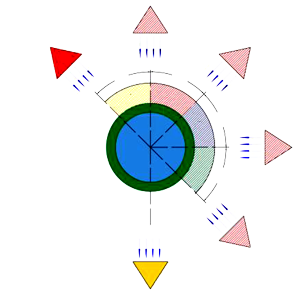Remote identification of liquids in a dielectric container using millimeter waves. 3. Angular scanning
DOI:
https://doi.org/10.3103/S0735272719010035Keywords:
microwave bands, radiometry, radio brightness temperature, refined products, aqueous-alcoholic solutions, remote identificationAbstract
The use of radiometric and quasi-optical principles enables obtaining remote thermal portraits of the studied liquids in a closed dielectric container for distances from few centimeters to several meters. Microwave angular polarization radiometric scanning was used for the first time, and allows to remotely obtaining authentic thermal portraits for liquids that are similar in their physicochemical properties. It was experimentally shown that objects that have nearly indistinguishable thermal portraits (water-alcohol solutions, diesel fuels) in case of linear scanning, reveal signatures that make it easy to identify them and also to distinguish the dielectric containers for liquids in case of angular scanning. The method of angular radiometric scanning enabled obtaining the components of transmitted, absorbed and reflected waves for the authentication of liquids based on their thermal portraits in one measurement cycle. The broadband noise electromagnetic wave generated by the illumination source carries the information about the liquid and the container. The use of angular scanning reduced the time for obtaining useful information to 14 s or 4 times compared with linear scanning. The results of the study of hazardous liquids are presented on the example of combustible liquids: refined petroleum products (solvents, diesel fuels) and aqueous-alcoholic solutions in containers with dielectric constant ε = 2–16. It was experimentally shown that a microwave radiometric thermal portrait carries information about the number of molecules with a weak hydrogen bond in aqueous-alcoholic solutions. The proposed method for remote identification of liquids in a closed dielectric package is safe and environmentally friendly, since the required level of the illuminating noise radiation does not exceed the value of 20 dB/kT0.References
- PAVLYUCHENKO, A.V.; LOSHITSKIY, P.P.; SHELENGOVSKIY, A.I.; BABENKO, V.V. “Remote identification of liquids in a dielectric container using millimeter waves. 1. Principal possibility,” Radioelectron. Commun. Syst., v.60, n.10, p.423, 2017. DOI: https://doi.org/10.3103/S0735272717100016.
- PAVLYUCHENKO, A.V.; LOSHITSKIY, P.P.; SHELENGOVSKIY, A.I.; BABENKO, V.V. “Remote identification of liquids in a dielectric container using millimeter waves. 2. Linear scanning,” Radioelectron. Commun. Syst., v.61, n.4, p.157, 2018. DOI: https://doi.org/10.3103/S0735272718040039.
- SALMON, Neil A. “Outdoor passive millimeter-wave imaging: Phenomenology and scene simulation,” IEEE Trans. Antennas Propag., v.66, n.2, p.897, Feb 2018. DOI: https://doi.org/10.1109/TAP.2017.2781742.
- LEE, Jeffrey S.; CLEAVER, Gerald B. “The cosmic microwave background radiation power spectrum as a random bit generator for symmetric- and asymmetric-key cryptography,” Heliyon, v.3, n.10, 2017. DOI: https://doi.org/10.1016/j.heliyon.2017.e00422.
- OWDA, Amani Y.; SALMON, Neil; REZGUI, Nacer-Ddine. “Electromagnetic signatures of human skin in the millimeter wave band 80-100 GHz,” PIER B, v.80, p.79, 2018. DOI: http://doi.org/10.2528/PIERB17120403.
- SAMAVI, S.; SHIRANI, S.; KARIMI, N. “Real-time processing and compression of DNA microarray images,” IEEE Trans. Image Processing, v.15, n.3, p.754, Mar 2006. DOI: https://doi.org/10.1109/TIP.2005.860618.
- DIVIN, Y.; LYATTI, M.; POPPE, U.; URBAN, K. “Identification of liquids by high-Tc Josephson THz detectors,” Phys. Procedia, v.36, p.29, 2012. DOI: https://doi.org/10.1016/j.phpro.2012.06.125.
- ALIMENTI, Federico; ROSELLI, Luca; BONAFONI, Stefania. “Microwave radiometers for fire detection in trains: Theory and feasibility study,” Sensors, v.16, n.6, p.906, 2016. DOI: https://doi.org/10.3390/s16060906.
- “Practical physics. Cylindrical lense,” Nauka i Zhizn, n.12, p.24, 1994.
- MOSKALEV, V.A.; NAGIBINA, I.M.; POLUSHKINA, N.A.; RUDIN, V.L. Applied Physical Optics [in Russian, ed. by V. A. Moskalev]. St. Petersburg: Politekhnika, 1995, ISBN 5-7325-0010-3.
- ZELKIN, E.G.; PETROVA, R.A. Lens Antennas [in Russian]. Moscow: Sov. Radio, 1974.
- VINOGRADOV, A.V.; ORAEVSKIY, A.N. “Whispering gallery waves,” Soros Educational J., v.7, n.2, p.96, 2001.
- STRUTT, J.W. The Theory of Sound, Vol. 2. MacMillan and Co., 1926.
- PATSAEVA, S.V. “True nature of water-alcohol solutions,” Himiya i Zhizn, n.5, p.41, 2010.
- HARVEY, A.F. Microwave Engineering. Academic Press, 1963.
- LEFFLER, W.L. Petroleum Refining for the Non-Technical Person, 2nd ed. Penn Well Pub. Co, 1985.

Downloads
Published
2019-01-23
Issue
Section
Research Articles

